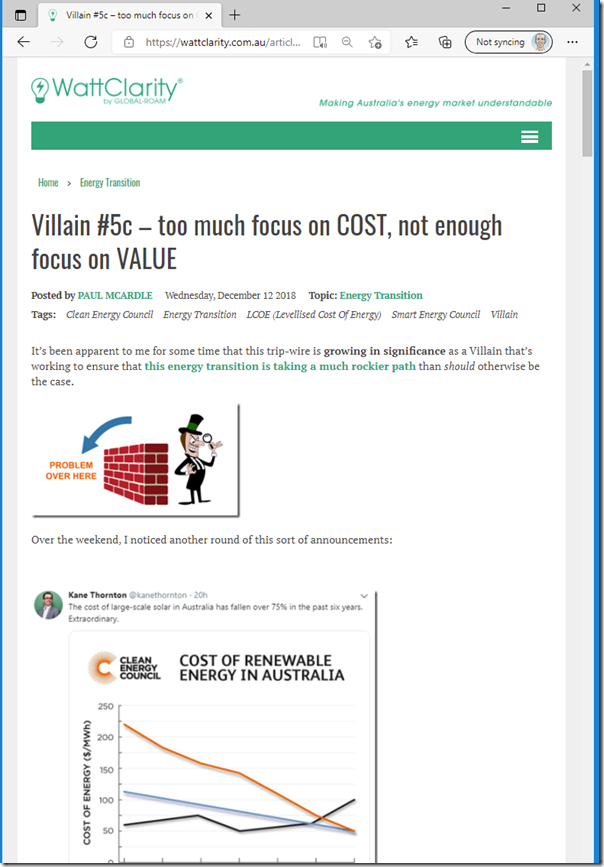Quite the coincidence….
I’d just finished reading Angela Macdonald-Smith’s article in the AFR this evening – ‘Yawning solar price gap slows growth’ – which I expect will be in the print copy on Monday morning:
Angela quotes a number of sources in her article, including:
1) Dylan McConnell’s analysis from the Climate Energy College – University of Melbourne (if I find it, I will link it in here later);
2) Our review of Q2 2021 published on Friday 2nd July; and also
3) JP Morgan analysis on forward price trends.
.. with the main thesis being:
“Plunging electricity prices during peak solar-generating hours are helping to slow the rampant rate of growth of large-scale solar power in the grid.
The discount in wholesale prices during peak daylight hours compared to the rest of the day has grown to as much as $40 a megawatt-hour, according to The University of Melbourne’s Climate & Energy College.”
(A) A real life example today (middle of the day, compared to this evening)
No sooner had I finished reading this than the market dished up another dose of evening spot price volatility – illustrating exactly what Angela has been speaking about in her article. Here’s the 18:25 dispatch interval this evening in NEMwatch (and early copy of v10.2 – which we’re working on for Five Minute Settlement):
During the middle of the day we had oodles of solar generation (over 7,000MW in total) which helped to drive prices negative at times across a number of regions – but in the same day we see the dispatch price for 18:25
(B) Further analysis
This is not just a ‘solar thing’!
(B1) Performance of wind is suffering
Back in 2015 we wrote about ‘the yin and yang of wind’, to illustrate and how that delivered a strong ‘wind correlation penalty’.
1) Using the ‘VWA Price’ metric from the GSD2019 I’d spoken about how wind farms were suffering (particularly in South Australia) in this article on 28th July 2020.
2) At least today the wind production has been consistently strong (around 3,000MW) … there were a number of evening occasions during Q2 2021 that saw very weak wind production patterns (perhaps 10% of what was there this evening).
(B2) Performance of solar is suffering
The ‘solar correlation penalty’ that’s the topic of Angela’s article is even stronger than that, and its impact is growing more rapidly:
1) In March 2021, Marcelle spoke at the CEC Large Solar Forum about the commercial performance of Large Solar … and after that posted three articles linked here about solar asset performance
2) The disappointing performance (of solar and wind) is leading to a rapid churn of ownership, with investors heading for the exits.
(B3) Why is this happening?
Perhaps this will be another reminder that many of us involved in this energy transition have spent far too much time thinking about COST, and not enough time focused on VALUE (which I noted was Villain #5c):
Yep – it’s not exclusively just a ‘solar thing’!
The above article was published in December 2018 … and thankfully since that time I have seen and heard more people talking about ‘value’ (that’s a great thing – though it’s still dwarfed by those focused more on input costs).
Fifteen months after that article I wondered about whether ‘We’ve been killing New Entrants with kindness?’ (i.e. Villain number 7) because of the form of support for renewables that (amongst other things) placed too much emphasis on ‘Anytime/Anywhere Energy’ and not enough on ‘Keeping the Lights on Services’.
This is something we’ll be seeking to explore further in GenInsights21.
——————
What Angela writes about in her article above is a natural (and very predictable) outcome of the incentives we have put in place.
Perhaps the boffins thinking about ‘NEM 2.0’ in the Post 2025 Market Design process might be able to address this?





The value of electricity always lies with demander/consumer. Up to any free entrant supplier to decide if they can compete with other like suppliers to meet that value with whatever costs they face. But the complexity lies in sum of consumer values at different times and likewise the costs of the various suppliers at those same times including frequency and voltage of said power of course.
Too much autocorrelation of values between consumers and costs between suppliers within each sector but they’re way out of sync with each other and hence those volatile prices reflecting that.
It clearly opens up opportunities for retiming hot water, demand response and thermal storage if not batteries. Wind developers will have to think about areas that are out of sync with the bulk of existing wind farms rather than maximum annual energy production Gippsland comes to mind, offfhsore or nearshore in southern NSW. Some existing wind farms may be repowered with taller towers and larger rotors without increasing nominal capacity but significantly increasing output in low wind conditions.
The 5 minute rule may also reduce the incentive to game the system at the high price end whether it will help at low prices is another mater.